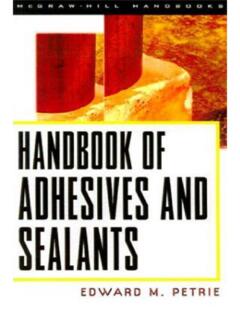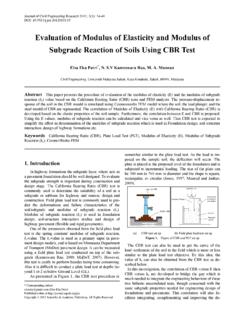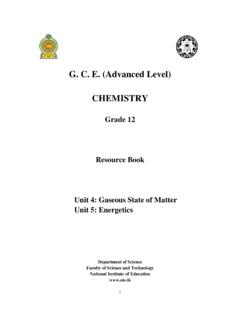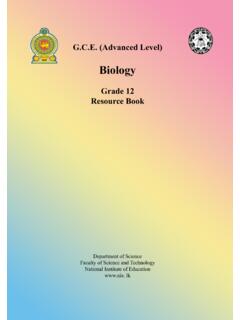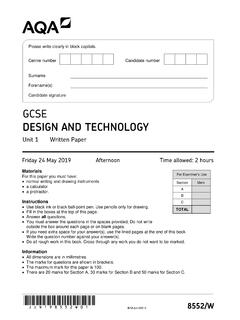Transcription of 2 - Ashby Method - cvut.cz
1 2 - Ashby Method - Introduction to Materials Selection Outline Materials and their attributes Materials and processes data Exploring relationships: material Property Charts Matching material to design: Screening and ranking Selection strategies and multi-objective optimisation Resources: M. F. Ashby , Materials Selection in Mechanical Design Butterworth Heinemann, 1999. The Cambridge material Selector (CES) software -- Granta Design, Cambridge ( ). The evolution of materials The world of materials Steels Cast irons Al-alloys Metals Cu-alloys Ni-alloys Ti-alloys PE, PP, PC.
2 Alumina PA (Nylon). Si-Carbide Polymers, Ceramics, GFRP elastomers glasses CFRP Butyl rubber Soda-glass Neoprene Pyrex Composites KFRP. Plyw ood Polymer foams Woods Metal foams Natural Foams materials Ceramic foams Natural fibres: Glass foams Hemp, Flax, Cotton Basic material properties Mechanical properties Thermal expansion General lo Weight: Density , Mg/m3. Thermal strain . l Expense: Cost/kg Cm, $/kg Expansion Mechanical coefficient, . Ductile materials Stiffness: Young's modulus E, GPa Temperature, T. Elastic limit, y Strength: Elastic limit y , MPa Stress.
3 Thermal conduction Fracture strength: Tensile strength ts , MPa x Young's modulus, E Brittleness: Fracture toughness K ic , T1 To Strain Area A Q joules/sec Thermal Brittle materials Expansion: Expansion coeff. , 1/K. Heat flux, Q/A. Tensile (fracture) Conduction: Thermal conductivity , Stress . strength, ts Thermal Electrical conductivity, . Young's modulus, E Conductor? Insulator? (T1 -T 0)/x Strain . Mechanical properties illustrated Stiff Strong All OK ! Tough Light Not stiff enough (need bigger E). Not strong enough (need bigger y ).
4 Not tough enough (need bigger Kic). Too heavy (need lower ). Materials information for design The goals of design: To create products that perform their function economically, safely, at acceptable cost . What do we need to know about materials in order to do this? Data Statistical Economic analysis Selection of capture analysis and business case material and process Mechanical Properties B ulk M odulus - GPa Com pressiv e Strength 55 - 60 MP a $. Ductility - E las tic Limit 40 - 45 MP a E ndurance Lim it 24 - 27 MP a Fracture Toughness - MP Hardness 100 - 140 MP a Loss Coefficient M odulus of Rupture 50 - 55 MP a P ois son's Ratio - S hear Modulus - GPa Tensile S trength 45 - 48 MP a Y oung' s Modulus - GPa Test Test data Design data Real Potential applications applications Characterisation Selection and implementation The nature of material (or process)
5 Data Unstructured data -- Structured data -- reports, papers, the Handbooks, Worldwide Web etc data sheets etc Numeric modulus, density . Rankings eg corrosion resistance in sea water? A,B,C,D,E. Boolean eg can be blow-moulded? Design guide-line Yes/No Descriptive info. FE. Standards Specific documentation modules Case studies Experience with the material Applications Codes Failure analysis Help lines Supply Consultants chain Non-specific documentation Data organisation: materials Kingdom Class &. Family member Attributes Density 1000.
6 Ceramics Mechanical props. 2000. Glasses Steels Thermal props. 3000. Polymers Cu-alloys Electrical props. Al-alloys 4000. material Metals 5000 Optical props. Ti-alloys Elastomers Ni-alloys 6000 Corrosion props. Composites Zn-alloys 7000 Supporting information Natural 8000. Processes Shapes A material record Structured data for ABS. Acrylonitrile-butadiene-styrene (ABS) - (CH2-CH-C6H4)n Thermal Properties General Properties Glass Temperature 350 - 360 K. Ma x Service Temp 350 - 370 K. Density - Mg/m^3 Min Service Temp 150 - 200 K.
7 Price - USD/kg Specific Heat 1500 - 1510 Thermal Conductivity - Thermal Expansion 70 - 75 10-6/K. Mechanical Properties Electrical Properties Bulk Modulus - GPa Breakdown Potential 14 - 15 MV/m Compressive Strength 55 - 60 MPa Dielectric Constant - Ductility - Resistivity - Elastic Limit 40 - 45 MPa Power Factor - Endurance Limit 24 - 27 MPa Fracture Toughness - 1/2. Hardness 100 - 140 MPa Corrosion and Wear Resistance Flammability Average Loss Coefficient Modulus of Rupture 50 - 55 MPa Fresh Water Good Organic Solvents Average Poisson's Ratio - Shear Modulus - GPa Oxidation at 500C Very Poor Tensile Strength 45 - 48 MPa Sea Water Good Strong Acid Good Young's Modulus - GPa Strong Alkalis Good UV Good Wear Poor Weak Acid Good Weak Alkalis Good Unstructured data for ABS.
8 What is it? ABS is a terpolymer one made by copolymerising 3 monomers: acrylonitrile, butadiene and syrene. It is tough, resilient, and easily moulded. ABS is opaque, or at best translucent, but it can be given vivid colours. It is used for casings, telephones, lego bricks, and small moulded parts such as the casings of computer mice. ABS- PVC alloys are tougher than standard ABS and, in self-extinguishing grades, are used for the casings of power tools. Design Notes. The acrylonitrile gives thermal and chemical resistance, rubber-like butadiene gives ductility and strength, the styrene gives a glossy surface, ease of machining and a lower cost.
9 ABS can be welded to ABS/PC, acrylic and itself, and it can be bonded with polyester, epoxy, alpha-cyanoacylate or nitrile-phenolic adhesives. Ultrasonic welding can reduce the strength of the material to 95% of the original; hot plate welding can reduce the strength to 80%. ABS can be extruded or formed to sheet. Thin (extruded) gauges of ABS can be easily processed on all types of forming equipment. A co-extrusion process or a special film overlay is recommended to extend the life of ABS for outdoor applications. Compression moulded heavy gauge ABS is often used for prototype model making.
10 ABS has the highest impact resistance of all polymers. It allows many colour options and has attractive aesthetic qualities. Integral metallics can be easily added (as in GE Plastics'. M agix.) ABS is UV resistant for outdoor application if stabilisers are added. Shaping. ABS is distributed as pellets for moulding or extrusion. The material is normally available a rod or sheet in a range of colours. Highlights. ABS is FDA compliant. It is readily available, easily machined, bonds well, product versatility, easily formed, good mechanical properties, cost, good impact strength (also at low temperatures), satisfactory stiffness, satisfactory dimensional stability, glossy surface, easy to machine, resistant to some bases and alcohol Warnings.
